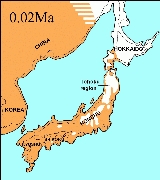
Japanese Paleolithic
Overview
Stone tool
A stone tool is, in the most general sense, any tool made either partially or entirely out of stone. Although stone tool-dependent societies and cultures still exist today, most stone tools are associated with prehistoric, particularly Stone Age cultures that have become extinct...
implements have been found, and continued to around 14,000 BC, at the end of the last ice age
Ice age
An ice age or, more precisely, glacial age, is a generic geological period of long-term reduction in the temperature of the Earth's surface and atmosphere, resulting in the presence or expansion of continental ice sheets, polar ice sheets and alpine glaciers...
, which corresponds to the beginning of the Mesolithic Jōmon period
Jomon period
The is the time in Japanese prehistory from about 14,000 BC to 300 BC.The term jōmon means "cord-patterned" in Japanese. This refers to the pottery style characteristic of the Jōmon culture, and which has markings made using sticks with cords wrapped around them...
. The 35,000 BC date is most generally accepted: any date of human presence before 30,000–35,000 BC is controversial, with artifacts supporting a pre–35,000 BC human presence on the archipelago still being of questionable authenticity.
The earliest human bones were discovered in Hamamatsu, Shizuoka
Hamamatsu, Shizuoka
is a city located in western Shizuoka Prefecture, Japan. On July 1, 2005, the city merged with 11 surrounding cities and towns. It became a city designated by government ordinance on April 1, 2007.- History :...
.
Unanswered Questions

